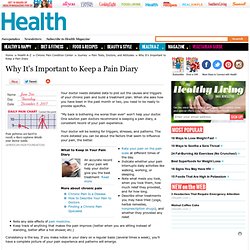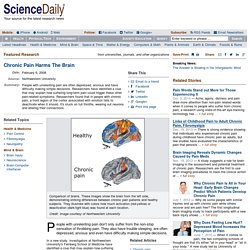

Cope With Chronic Pain - How to Cope With Chronic Pain. If you have chronic pain, it may be hard to imagine life without anxiety.

Constantly being in pain is stressful, and can lead to feelings of fear, helplessness and despair. Feeling bleak about the future of your chronic pain condition? Then keep reading, because there is hope. There are ways to learn to cope with chronic pain. Learning to Cope Effective coping strategies can impact your pain. While coping strategies won’t necessarily take your pain away, they can help you get it to a level that you can deal with.
Accepting Pain - Accepting Your Diagnosis You have a chronic pain condition. Accepting pain is not easy. Keep a pain journal. Being Mindful of Pain - What Helps and What Hurts? What times of day do you hurt the most? You can answer most of these questions by reading your pain journal. Taking Value-Based Actions - Make an Action Plan Being aware of your pain triggers and relievers helps you make better, more informed decisions about your behaviors. New Chronic Pain Diagnosis - Coping With a Chronic Pain Diagnosis. After all of the tests, all of the specialists and all of the worry, you've found out what the problem is -- you have chronic pain.

A formal diagnosis of chronic pain can finally help answer many of your questions. Now you know that you were not imagining things and the pain was not all in your head. But don’t be surprised if being diagnosed with a chronic pain disorder opens up a whole other door into the unknown. Sure, you know what you have. But now what? Even though you may have been searching for an answer, finding it can be hard. Disbelief – You may be stuck on exactly how you even got here in the first place. Keep in mind all of these stages do not happen for everyone, and they don’t always fall in this order. Do Some Research Learn everything you can about your diagnosis. Becoming aware of up-to-date information can greatly improve the outcomes of your medical care. Join a Community You are not the only one out there with a diagnosis of chronic pain. Set Some Goals Sources: Why It's Important to Keep a Pain Diary - Chronic Pain.
Pain patterns are hard to recall; a diary captures details your doctor needs.

Your doctor needs detailed data to plot out the causes and triggers of your chronic pain and build a treatment plan. When she asks how you have been in the past month or two, you need to be ready to provide specifics. "My back is bothering me worse than ever" won't help your doctor. One solution pain doctors recommend is keeping a pain diary, a consistent record of your pain experience. Your doctor will be looking for triggers, stresses, and patterns. What to Keep in Your Pain Diary An accurate record of your pain will help your doctor give you the best treatment Read more. About.com: American Pain Foundation. SpineU_neuroplasticity.pdf (application/pdf Object) Chronic Pain Harms The Brain.
People with unrelenting pain don't only suffer from the non-stop sensation of throbbing pain.

They also have trouble sleeping, are often depressed, anxious and even have difficulty making simple decisions. In a new study, investigators at Northwestern University's Feinberg School of Medicine have identified a clue that may explain how suffering long-term pain could trigger these other pain-related symptoms. Researchers found that in a healthy brain all the regions exist in a state of equilibrium.
When one region is active, the others quiet down. But in people with chronic pain, a front region of the cortex mostly associated with emotion "never shuts up," said Dante Chialvo, lead author and associate research professor of physiology at the Feinberg School. They are stuck on full throttle, wearing out neurons and altering their connections to each other. This is the first demonstration of brain disturbances in chronic pain patients not directly related to the sensation of pain.